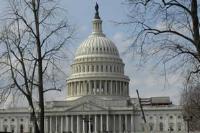
New Managing Director for Bellona Norway
The Board of the Bellona Foundation has appointed former Minister of Climate and the Environment Sveinung Rotevatn as Managing Director of Bellona No...
News

Publish date: February 6, 2007
Written by: Svend Søyland
News
According to an analysis of the proposal by the Energy Information Administration (EIA) presented two weeks ago, the Bingaman amendment will neither hurt US employment or the US economy.
As currently envisioned, the Bingaman amendment will decrease emissions by two to five million tons between 2015 and 2030. But emissions will again shoot up by several a half a million tons above emissions targets beginning in 2020, reaching highs in 2030.
The Bingaman amendment, therefore, seems to bank on those emissions cuts that will come in the decades preceding that: a 5 percent decrease (372 million tons) by 2015, an 11 percent decrease (909 million tons) by 2025, and a 14 percent decrease (1259 million tons) by 2030. These projections are assumed to incorporate programs that will curtail emissions.
Yet the Bingaman amendment to the Energy Policy Act of 2005 is only one of several others under consideration – most notably the McCain-Leiberman and the Sanders-Boxer-Waxman amendments, which envision far deeper cuts in emissions. The McCain-Lieberman amendment envisions emissions cuts of up to 40 million tons by 2050 and the Sanders-Boxer-Waxman proposal sets an emissions reduction target of 60 million tons, according to figures compiled by the World Resources Institute.
Congressional staffers interviewed by Bellona Web, however, indicated that the Bingaman amendment is the only proposal that is conservative enough to actually pass into law. The vote on the proposals is expected to come in autumn, staffer said.
Safety valve
The financial safety valve proposed in the Bingaman amendment sets a $7 limit per ton for excess carbon monoxide equivalents (COE) produced by US industry. Bingaman has recently become the new majority leader on the Senate Energy and Resources Committee, positioning him to aggressively push for amendment to the Energy Policy Act.
The proposed Bingaman amendment follows the spirit of a Senate resolution that bars climate legislation that would hurt the US economy. The $7 per ton of COE cap would increase annually by 5 percent above projected inflation rates.
The proposed amendment would establish annual emission limits to reduce greenhouse gas "intensity," which will be established by dividing greenhouse gas emissions by the forecasted US gross domestic product (GDP) for a given year. This intensity would be reduced by 2.6 percent annually between 2012 and 2021, and by 3 percent in 2013, according to the EIA’s analysis.
Compliance costs under the proposed amendment would be kept down by allowing companies to trade, save, and borrow emissions credits. Companies would also be allowed to generate emissions credits by inducing non-participating businesses, farms and others to either reduce their greenhouse gas emissions or encourage them to capture and store greenhouse gasses.
Under the proposed amendment, emissions credits would be invested, and the dividends applied toward deploying advanced technologies and implementing greenhouse gas reduction practices.
A tenth of a percent effect on a growing GDP
The EIA, which is an independent analysis unit within the US Department of Energy (DOE), released its analysis of the Bingaman proposal and its associated costs to the US economy last month.
The EIA found that the proposed mandatory steps to reduce greenhouse gas emissions could be achieved at a low cost to American households and businesses without harming the US economy. The amendment would result in a mere 0.1 percent reduction of the projected GDP through 2030. This corresponds to a cumulative GDP that is expected to double from 2006 to 2030.
Coal usage down – but nuclear remains the same
Coal use would grow by only 23 percent by 2030, compared the projected 53 percent that would result without the program outlined in the proposed Bingaman amendment.
Natural gas demand is thought to increase by merely 1 percent by 2030. Non-hydro renewable electricity generation would rise by 53 percent by 2030.
Nuclear energy, however, will retain 20 percent of its power market share, despite a sharp decline in the business due to aging equipment. This means that many new reactors will be constructed so the nuclear utility can hold on to its 20 percent share.
If the Bingaman amendment becomes policy, the emission levels will be below targets between 2011 and 2020. Sadly, after 2020 there will be a widening gap between actual emissions and emission targets. In 2030, the actual emissions will be between 750 and 1000 million tons more than the emissions target for the same year.

The Board of the Bellona Foundation has appointed former Minister of Climate and the Environment Sveinung Rotevatn as Managing Director of Bellona No...

Økokrim, Norway’s authority for investigating and prosecuting economic and environmental crime, has imposed a record fine on Equinor following a comp...

Our op-ed originally appeared in The Moscow Times. For more than three decades, Russia has been burdened with the remains of the Soviet ...

The United Nation’s COP30 global climate negotiations in Belém, Brazil ended this weekend with a watered-down resolution that failed to halt deforest...